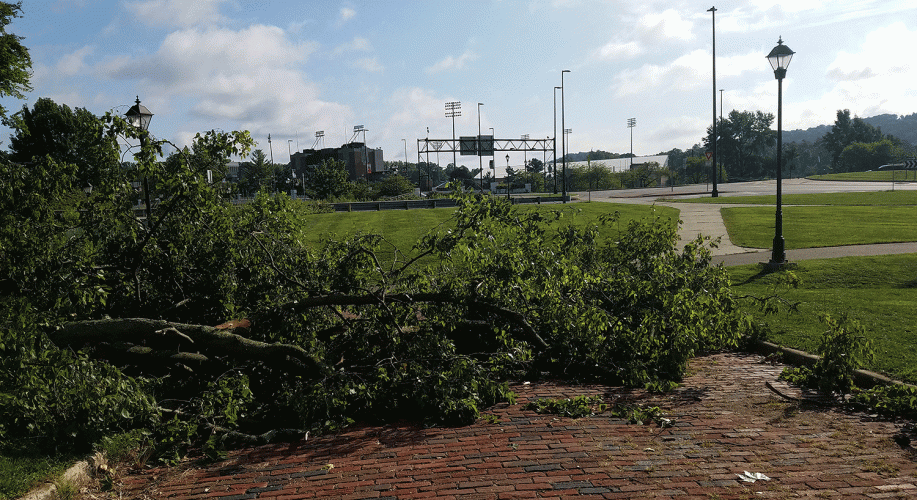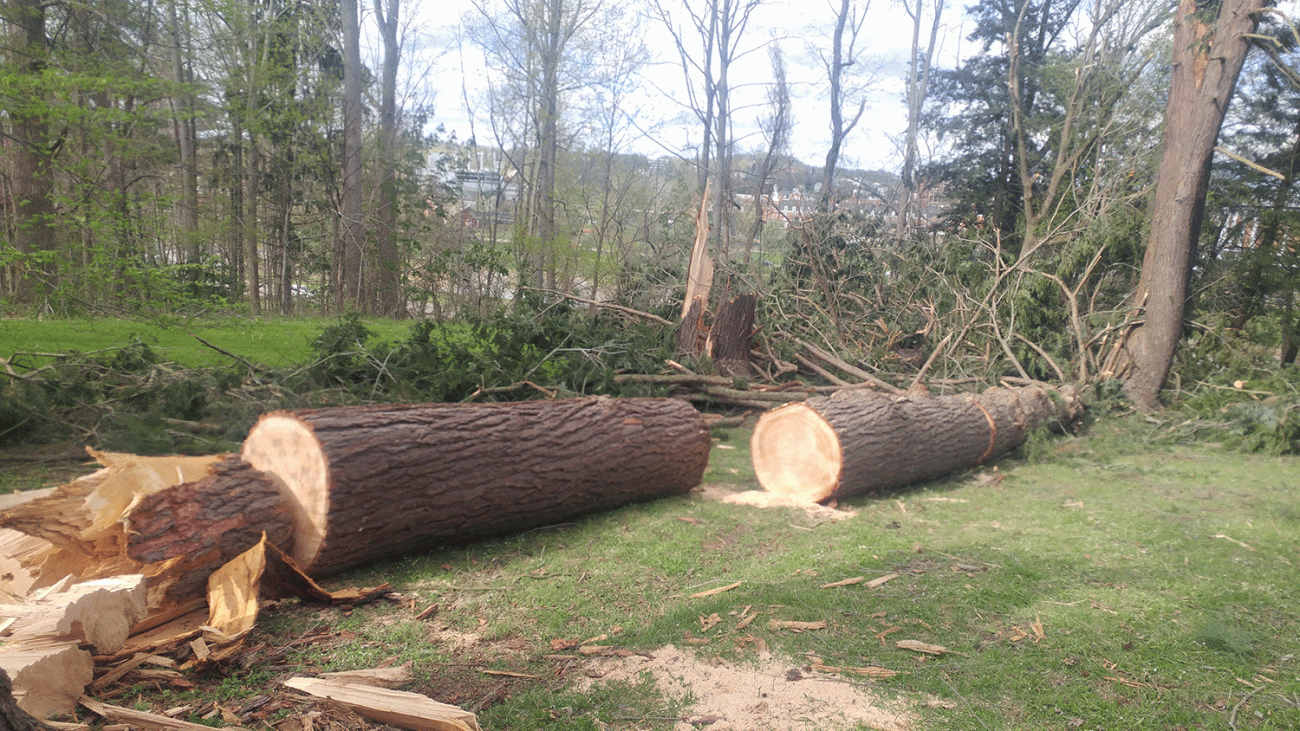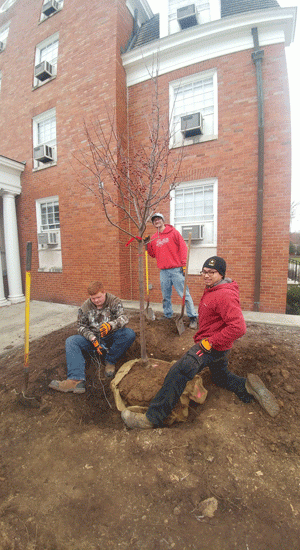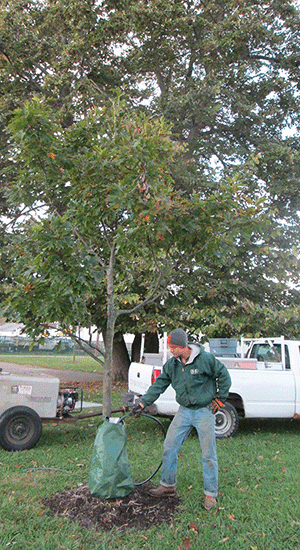
Grounds Services working hard to keep Athens Campus trees healthy

Ohio University Athens Campus trees regularly face serious challenges, including soil compaction, invasive species and extreme weather.
OHIO Landscape Coordinator Susan Calhoun recently shared some of the measures the University takes every day to keep them alive and healthy and several ways the community can help.
Extreme weather
Southeast Ohio received plenty of rainfall during the 2019 season until the rains stopped abruptly near the end of August when hot, dry, weather took control for about six weeks. This created beautiful blue skies, but the weather change was pretty extreme (meteorologists are calling this event a “flash drought”) and most plants struggled to adjust. Many trees shed their leaves early as a survival strategy.
“As the dry conditions persist, trees and other plants, especially those that were recently planted will become more stressed,” said Susan Calhoun, landscape coordinator at OHIO.
In response to the drought situation, Ohio University Grounds Services irrigated trees using plastic gator bags, which allow 20 gallons of water to drip out over a 24-hour period. This method provides water at a rate that can be absorbed without losing water to run-off or evaporation.
Thankfully the drought situation was eased by a big drop in temperatures (from the 90 degree range into the 70s). In addition, much-needed rain fell Oct. 6-7 resulting in more than 2.5 inches for the Athens area.
On the other weather extreme, the wet humid conditions that Athens experienced throughout spring and summer created an ideal environment for fungal pathogens that damaged the needles on evergreens, such as the Colorado Spruce and Norway Spruce. Grounds Services has removed many of these evergreens over the past two years due to fungal needle damage.
Another weather impact has been wind and storm events. So far in 2019, there have been four high wind events that have damaged many trees on campus.

Soil Compaction
Soil compaction caused by maintenance equipment, construction equipment and pedestrian traffic poses yet another threat to tree health. It creates problems for the root system because it causes poor drainage, a low oxygen environment and makes it difficult for roots to penetrate the soil. Compaction issues can be prevented during construction projects by creating tree protection zones in which the trees’ roots are protected by a fence.
“Preventing equipment from driving in the vicinity of the tree roots and across yards during wet ground conditions can be a solution, as well as spreading mulch or using ground pads in pathways through a construction site,” Calhoun said.

Insects and Invasive species
Calhoun shared some of the major invasive insect species that affect Athens campus trees:
The Emerald Ash Borer is an invasive beetle from Asia that attacks and kills all species of native North American Ash trees by destroying the tree’s vascular system. In 2016, Grounds Services treated approximately 100 Ash trees in key landscape locations by injecting them with a systemic insecticide that protects them from the insect. This cycle was repeated in the spring of 2019.
“Theoretically, as the pest pressure recedes (Emerald Ash Borers run out of food because they kill most of the ash trees), the cycle between treatments should become longer, requiring fewer treatments,” said Calhoun.
The Hemlock Woolly Adelgid is an invasive insect species originating from Japan that attacks and kills North American Hemlock trees. Grounds Services with the help of Meg Little, a former graduate student, assisted in setting up training tours for groundkeepers to scout for the insect during the winter of 2019. Thankfully, no HWA were found, but another pest called the Elongate Hemlock Scale was detected on Hemlock trees. The affected trees were treated during the spring of 2019.
“Both pests will be monitored and treated if necessary. In addition, Meg created a map of existing Hemlocks growing in managed areas on campus for use in future scouting efforts,” Calhoun said.
More information about the Hemlock Woolly Adelgid can be found at: https://ag.umass.edu/landscape/fact-sheets/hemlock-woolly-adelgidhttps://www.nrs.fs.fed.us/disturbance/invasive_species/hwa/
Other invasive species are plants. Invasive vines grow rapidly and cover canopies, affecting tree health by preventing food production in the leaves. Vines such as Porcelain Vine, Akebia, Asian Bittersweet and Japanese Honeysuckle are annually removed throughout campus. There are also several invasive species of trees and shrubs that can out-compete our native trees and even change soil chemistry.
“Shrubs and small trees such as the Japanese Bush Honeysuckle and Autumn Olive are examples, while large trees such as the Tree of Heaven are monitored and removed when they are encountered on campus.” Calhoun said.
Prevention steps
The following measures can be taken to prevent tree loss:
1. Planting disease and pest resistant species.
2. Choosing a tree to match the correct hardiness zone (low temperature tolerance)
3. Siting the tree properly according to its needs, such as light and soil conditions, moisture needs and available space corresponding to mature tree size.
4. Providing cultural care such as creating a mulch ring. This reduces the possibility of mower and weed eater damage, reduces competition from turf, and moderates temperature and moisture swings. Another important task to perform is pruning while the tree is young to promote proper structural development.
5 Providing support during times of stress: This could include pest monitoring with potential damage mitigation and watering during drought conditions.

Help from the community
The community is asked to use common sense when choosing a tree to “hammock” in. Choose trees with a minimum diameter of 7 inches and look for trees with thick bark. Please avoid trees with hazards, such as thorns or dead limbs and do not climb or hammock in the much-loved Japanese Cherry trees, which are planted along the bike path at the edge of the Hocking River.
Acceptable locations are along the west side (Oxbow Drive side) of Emeriti Park, in the Aquatic Center’s Walnut Grove and behind the Front Four dorms of South Green where there are many large trees.
“Ideas such as the possible construction of Hammock Parks are being discussed allowing students to hang their hammock on posts set under shade trees,” Calhoun said.
The community is also asked to support tree planting wherever and whenever you can. Whether by lending physical labor or by donating resources to tree planting and promoting organizations or land preservation organizations that prevent or carefully manage tree removal.
“It takes time for trees to grow large enough to create shade, absorb storm water and provide food and habitat for other living things. Investing in planting and preserving trees is key,” Calhoun said.
